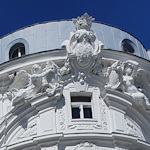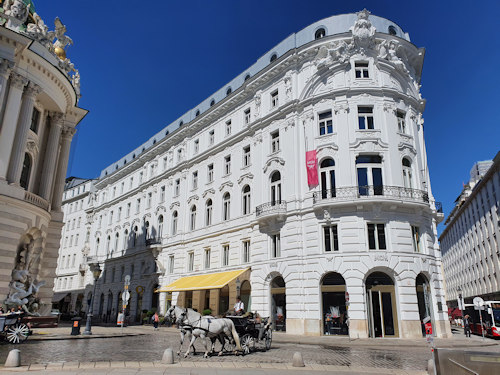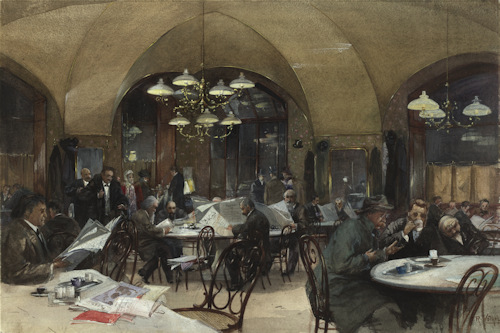
Michaelerplatz square has its fair share of buildings rich in history and one example is Palais Herberstein. Though this proud townhouse might be more famous for its predecessor.
- Constructed just before 1900
- Built on the site of Palais Dietrichstein, which housed Café Griensteidl (a legendary literary coffee house)
- Book a historical walking tour* of Vienna
- See also:
A Café trumps a Palais

(Once a haunt of famous writers)
Back in the mid-19th century, Count Herberstein came into ownership of Palais Dietrichstein, an impressive building on the edge of the Hofburg palace complex where the Habsburgs lived and worked.
The end of that century was a time of redevelopment in Vienna, with buildings shooting up all over the place. No surprise, then, that Herberstein decided to rebuild his property; architect Carl König put up a new palais in the late 1890s.
This Palais Herberstein took the adjoining Imperial residence as its role model, which included putting a dome on top. Which is fine in theory, but some observers of the time thought it a little disrespectful to pretend to some kind of equivalence with the emperor.
Anyway, various redevelopment works saw the dome disappear and the building grow in height to today’s imposing construction that guards the entrance to Herrengasse.
Incidentally the same aristocratic family owned huge swathes of the province of Styria, south of Vienna.
The coffee house connection

(An outside view of the palais from 1896, just before its demolition I think. Painted by Franz Kopallik; Wien Museum Inv.-Nr. 166629; excerpt reproduced under the terms of the CC BY 4.0 license)
Although a fine building in its own right, Palais Herberstein’s place in Viennese history comes largely through its predecessor.
Palais Dietrichstein went up around about the same time that Wellington and friends put an end to Napoleon at the Battle of Waterloo.
Some 30+ years later, a chap named Heinrich Griensteidl moved his coffee house into the building. His imaginatively-named Café Griensteidl disappeared a few decades later along with Palais Dietrichstein.
Under normal circumstances, a 19th-century café barely deserves comment. It’s not like Vienna had a paucity of them. But Café Griensteidl played a key role in the rise of the coffee house as driver of cultural change and intellectual discussion.
The high point of this phenomenon came in the years around 1900, when Vienna was a seething mass of intellectual progression and creativity.
All sorts of artists, architects, philosophers, politicians and the like would meet in the city’s coffee houses. Think Freud and Klimt, for example. And the list of coffee house intelligentsia included numerous authors, of course.
Café Griensteidl was a famous early protagonist of this cultural movement and known particularly for the writers that collected within its walls, including the Young Vienna group that featured the likes of Felix Salten (author of Bambi).

(Interior of Café Griensteidl, as painted by Reinhold Richard d. J. Völkel in 1896; Wien Museum Inv.-Nr. 62352; excerpt reproduced under the terms of the CC BY 4.0 license)
The German word Kaffeehausliteratur actually refers to “coffee house literature”: writing completed in whole or part in a coffee house.
Most consider Vienna the traditional home of Kaffeehausliteratur, which finds its modern global expression when authors sit in Starbucks using the Wi-Fi on their laptops. (Ironically, there’s a Starbucks on the other side of the square from Palais Herberstein.)
Café Griensteidl remains a cultural beacon in the consciousness of many Viennese. So much so that the name at least made an occasional return to Palais Herberstein, though none of those initiatives could match the history and reputation of the first café.
Today, you can still buy coffee at the address but only in the supermarket that moved in in 2020.
How to get to Palais Herberstein
Just follow the tips at the end of the main Michaelerplatz article.
Address: Herrengasse 1-3, 1010 Vienna